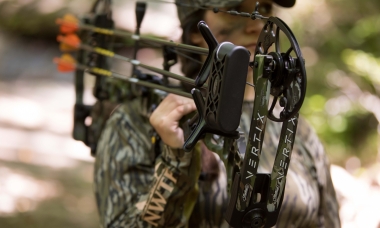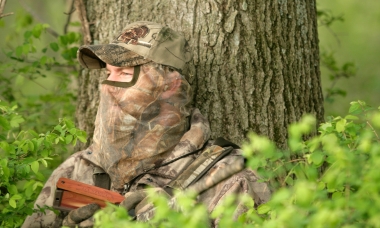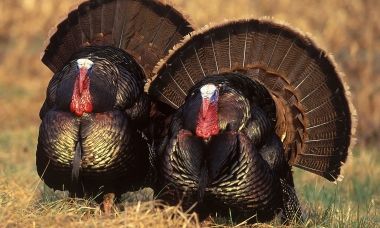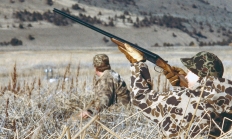
Search myodfw.com
While turkey hunting is one of the safest forms of hunting, there are some safety tips hunters should follow. Be visible when you need to be The biggest risk in turkey hunting is being in the woods with other turkey hunters. Remember, everyone will be wearing camouflage and sounding like a turkey as they try to call in birds (including you). Therefore, you’ll want to make sure you and your location are visible while you’re walking to the blind or setting up, while you’re set up behind a tree and while you’re carrying your bird out of the field. A


There are two steps in patterning your gun: Verify your point of impact. Confirm the pellets are hitting where you’re aiming. Often called sighting in. Check the pattern of the pellets to see what loads shoot most accurately. Often called patterning. Sight in scopes and fiber optic sites If you’re shooting a shotgun with a single bead on top of the barrel, you can go right to patterning. If you’re shooting a shotgun mounted with a scope or reflex sight, or a fiber optic front and rear site, you’ll need to sight in the gun before you pattern it. Start


Before shooting a bow, you’ll want to make sure it's safe to fire. Bow/arrow safety check list Check that the string and cable are in good condition and aren ’t rubbing or fraying at any point. Use bowstring wax regularly to keep your string in good condition and safe to shoot. Check that the cams, limbs and riser are all in good shape. Look for cracks, dents, breaks, delaminations, peeling fiberglass, and any mechanical parts that may be defective. If any part of the bow is suspect, don’t shoot it. Fix it or take it to an archery shop to

Practice shooting your bow regularly and you’ll develop the form and muscle memory you need to shoot accurately and confidently. Places to shoot from the backyard to the backcountry You can practice your shooting anywhere it’s safe and outside of urban growth boundaries. It's also illegal to shoot in the direction of any person, building, structure or vehicle within the range of your bow. So be sure there's y a clear line of sight between you and the target, and a safe backstop. Possible locations include: A large backyard in a rural setting Archery specific indoor and outdoor target ranges

There are basic rules of safety and etiquette that apply at archery ranges. Be sure you’re following them. Etiquette on the range Etiquette is an important part of a fun, positive and safe experience on the archery range. Proper range etiquette starts with safety, for you and others around you. Keep arrows pointed down range. Give fellow shooters plenty of space, and never cross into their shooting lane with your body or equipment. Pay attention to what ’s going on around you, especially when leaving or entering the shooting line. Straddle the shooting line -- one foot on each side

Shooting accurately starts with the proper form, and that begins with a good stance. From your feet up through your hips and torso, a solid foundation in your lower body will improve your shooting. Start with an open stance The “open” stance is a good one for beginners. It’s easy to master and to practice consistently. An open stance positions yours hips and shoulders in-line with the direction you ’re shooting. This perpendicular setup to the target is simple to do. First, place one foot on each side of the shooting line. Most ranges will have these lines. If not

To be an accurate shooter, it’s important to develop a consistent grip and draw. One of the most common mistakes bowhunters make is tensing up and gripping the bow too firmly. A firm grip will torque the bow, or send it out of alignment, resulting in a poor shot and perhaps a painful slap on your arm from the bow string. Develop a consistent grip The grip of the bow should rest on the pad of your thumb and should not cross the lifeline of your hand. With the bow in this position, your fingers will be off to the


Turkey behavior changes over a hunting season. So it helps to think a bit like a turkey when planning your strategy for finding turkeys and setting up your hunt. Spring turkey behavior By the time hunting season opens on April 15, most of the hen turkeys have already bred. Though they may not be sitting on their nests quite yet. This keeps tom turkeys close to the hens during the first few weeks of the season, making it difficult for hunters to lure toms away from hens and into shooting range. If tom numbers are low, they are less likely

Turkeys don’t like to fly at night, so the best time to get set up for your hunt is either right before dark the day before your hunt. Or before daylight the day of your hunt. Once you ’ve located a tom, either seeing it or by hearing it gobble, it’s time to make a plan. The goal is to get close enough to call in a tom, without letting him know you’re there. Be in place before daylight If you’ve been out the night before and used a locator call to find a tom on his roost, get to

When it comes to turkey hunting from a ground blind, popup blinds are ideal. Popup blinds set up in minutes and are easy to move around. You also can construct a blind from natural materials, but it’s time consuming and you can’t take the blind with you to your next hunting location. The best blind for you One-person popup blinds are small and portable, but there’s not much room to move. Unless a bird approaches and stops directly in front of you, you may not get a shot. The best blind for most turkey hunters is a larger, two-person, 360º


In the spring, hunters try to take advantage of a tom’s predicted behavior during breeding season to bag a bird. In the fall, hunters fill their turkey tags by studying food sources and the daily routine of birds. Turkeys follow food sources As fall progresses, food sources for turkeys change. In late summer and early fall, turkeys largely feed on high-protein insects. Grasshoppers are a primary food source throughout Oregon this time of year. Silk worms, caterpillars, spiders and other bugs make up a good part of a turkey ’s fall diet. As fall leads to winter, earthworms and a

Spring turkey hunting is about appealing to a tom’s urge to mate. Fall hunting, on the other hand, is about keying in on a flock’s daily routine. Look for a lone bird As fall turkey flocks become established, there’s a pecking order in each group. It’s not uncommon for a lone bird – usually a jake or young tom – to be wandering by himself looking for a flock to join. If you spot a lone bird, waste no time trying to get in front of him to set up and call. Don’t intimidate the lone bird with aggressive calling


Turkeys make a lot of different sounds, many of which are different in spring and fall. Though most hunters can routinely fill tags by using only two or three sounds, it’s good to know what other sounds turkeys make and why. The hen yelp and variations The most commonly heard sound in the turkey woods is made by the hen, and it’s called a yelp. Toms also yelp, but it’s louder, raspier and often more drawn-out than that of hens. The yelp is usually delivered in a series of one-note tunes. However, yelps can take on various forms. Specifically, there



